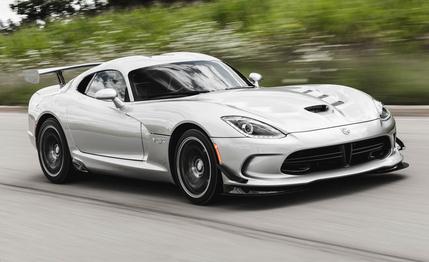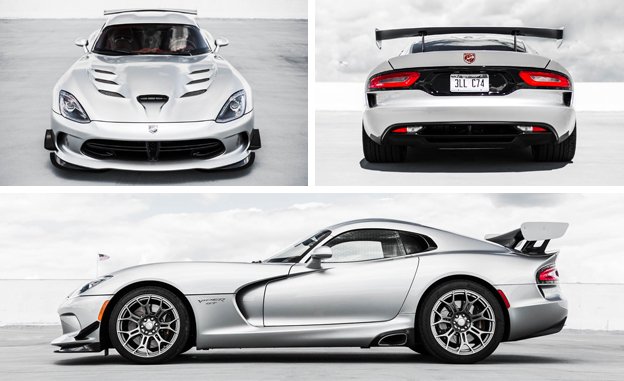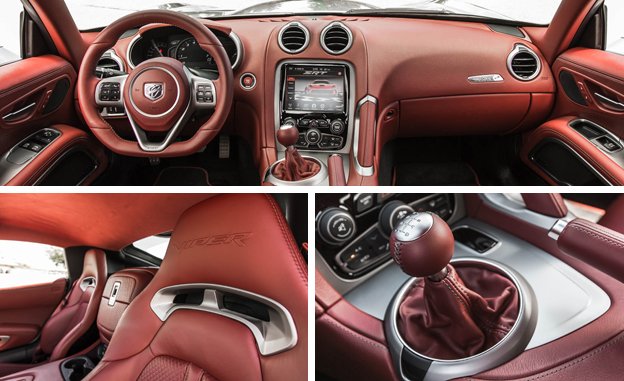
 Instrumented Test
Instrumented Test
Truly unique cars are few and far between these days. Every manufacturer is finding new ways to share components. And most models’ color combinations are limited to shades of silver with tones of beige or gray inside. It’s a miracle the Dodge Viper’s low-volume Detroit, Michigan, assembly line continues to birth snakes with a 645-hp pushrod V-10 heart, an engine that is, for all intents, unique. One has to imagine that if Mr. Marchionne had his way with a merger, the Viper’s near-nonexistent capability for sharing would relegate the American anti-Corvette to the scrap heap for good.
For now at least, the Viper carries on. Our newest test example wore a custom interior and paint designed by a guy named “Sneaky Pete,” or so says a badge on the dash. Mr. Pete chose a beautiful multidimensional silver paint and an all-red interior for this GTC model. But this car’s hierarchical place in the Viper pit is a little confusing. The GTC is above the base Viper SRT and the next-up GT and below the GTS model, but both the GTC and GT wear “GT” badges on their front fenders.


To add to the confusion, Sneaky, as friends call him, added the GTS interior package ($8500), bringing a full leather cockpit. Does this make the car a GTS? No, not really. The Time Attack Group 2.0 package ($8700) was also fitted. So this is a TA 2.0, right? Not quite. True TAs are built on the base SRT and come with cloth seats and a plastic dash. The Time Attack Groups (both the 1.0 and the winged 2.0, like this one) include the majority of the TA’s go-fast bits—suspension, wing/spoiler, splitters, brakes—but not all of them. Two notables missing are the SRT hood (six hood vents versus the GTS hood’s two) and the carbon-fiber X-brace (a really fancy strut-tower brace that saves 2.9 pounds over the standard brace), although both of those were added back into this car, for $500 and $2800. It wouldn’t be totally incorrect to call Pete’s car the nicest TA 2.0 out there.
“Sneaky Pete” is actually the nickname of the original 1990s Viper logo and not a person, and it is the name Dodge picked to apply to this example of the Viper’s new custom process called “1 of 1.” The program offers more than 50 million possible combinations of paint, interior, and stripe color. Dodge also limits the color combos to first come, first serve. To ensure each “1 of 1” is unique, Dodge will make you wait for the following model year if, for example, you want a white-on-white Viper with an off-white stripe and an identical one was already ordered. Pick your own hues here.
With a few other line items, this Pete-designed Viper totaled $126,085. It’s capable of accelerating to 130 mph in an 11.5-second quarter-mile. That, my friends, is smoking fast. A Chevy Corvette Z06 manual will match its time in the quarter, but the Vette is traveling 5 mph slower. By 150 mph, the Chevy lags by 1.3 seconds. First gear in the Viper is good for 60 mph. Each shift feels like you’re flipping the world’s heaviest light switch. The shifter snaps into place just after entering each gate. If you’re missing shifts in this car, you’re likely driving with one hand on top of the wheel, too.


With the ACR now out of confinement, the TA 2.0 and Time Attack Group 2.0 Vipers are no longer the heaviest hitters on a track. It isn’t for a lack of trying. All Vipers—be they the base car or track-spec—are stubborn, stiff, and loud. Tiny cracks in the road resonate through the ultra-rigid chassis like firecrackers in a drum, and the wide Pirelli rubber constantly fills the cabin with the kind of low-frequency drone only a locomotive engineer could ignore. But that’s at posted speeds. The faster the car goes, the less the sounds bother you, the driver. Grip is plentiful, measured at 1.03 g on a 300-foot circle. But you can only go so fast through so many corners before passengers start to make sounds of their own.
And cornering hard is where this car feels at home. Going straight down the road, the hefty-weighted steering wheel kicks back, darting off-center like it’s urging you to turn. Tall gearing, while helping to achieve an EPA rating of 21 mpg on the highway, isn’t great in traffic or on moderate inclines. Dropping a gear or two is necessary in a lot of situations. We averaged 14 mpg, 2 higher than the city rating.
When it comes down to it, you have to really want to drive the Viper to the store when you have other options available. The side exhaust warms the sills like stale fries under a heat lamp, and the cabin feels tight at times. And any Viper demands a more special task than a run to the grocery store. The good and bad parts combine for a driving experience unlike any other production car. One might say it’s one of a kind, even beyond Mr. Pete’s own GTC.